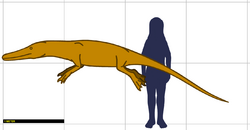Biology:Remingtonocetus
| Remingtonocetus | |
|---|---|

| |
| Life restoration of R. harudiniensis | |
| Scientific classification | |
| Domain: | Eukaryota |
| Kingdom: | Animalia |
| Phylum: | Chordata |
| Class: | Mammalia |
| Order: | Artiodactyla |
| Infraorder: | Cetacea |
| Family: | †Remingtonocetidae |
| Genus: | †Remingtonocetus Kumar & Sahni 1986 |
| Species[1] | |
| |
Remingtonocetus is an extinct genus of early cetacean freshwater aquatic mammals of the family Remingtonocetidae endemic to the coastline of the ancient Tethys Ocean during the Eocene. It was named after naturalist Remington Kellogg.
History of discovery
Sahni & Mishra 1975 named Protocetus harudiensis based on a partial skeleton, the type specimen found in the Lutetian shallow subtidal mudstone in the Harudi Formation, India . Kumar & Sahni 1986 renamed it Remingtononocetus harudiensis due to morphological differences from protocetus.[2]
Remingtonocetus domandaensis was named by Gingerich et al. 2001 based on a partial skeleton found in a Lutetian coastal shale in the Domanda Formation of Pakistan .[3] Remingtonocetus is larger, has a broader rostrum, and longer premolars than Andrewsiphius. It is smaller than, has more gracile premolars and molars than Dalanistes. R. harudiensis differs from R. domandaensis in molar morphology.[4]
Description
Remingtonocetus was a small cetacean with R. harudiensis weighing 198–576 kg (437–1,270 lb).[5] Gingerich et al. 2001 interpreted R. domandaensis as an older and more generalized species than R. harudiensis. Based on a morphological analysis, they concluded that the hindlimbs of Remingtonocetus were probably not weight-bearing, and that (1) the fused sacrum indicates a limitation in tail-powered locomotion, and (2) the presence of powerful hip extensors and femoral adductors indicates that Remingtonocetus was an efficient and specialized foot-powered swimmer.[6]
Remingtonocetus had four working and usable limbs, a slender whale-like body with long tail and slender, hydrodynamic head.
Taxonomy
Remingtonocetus was named by Kumar & Sahni 1986. Its type is Protocetus harudiensis. It was considered monophyletic by Uhen et al. 2011. It was assigned to Cetacea by Sepkoski 2002. To Remingtonocetidae by Kumar & Sahni 1986, Gingerich & Russell 1990, Benton 1993, McKenna & Bell 1997, Bajpai & Thewissen 1998, Williams 1998, Thewissen et al. 2001, Gingerich et al. 2001, Geisler & Sanders 2003, McLeod & Barnes 2008 and Uhen et al. 2011.[1]
See also
Notes
- ↑ 1.0 1.1 Remingtonocetus in the Paleobiology Database. Retrieved 31 March 2013.
- ↑ Remingtonocetus harudiensis in the Paleobiology Database. Retrieved 31 March 2013.
- ↑ Remingtonocetus domandaensis in the Paleobiology Database. Retrieved 31 March 2013.
- ↑ Gingerich et al. 2001, pp. 289, 291
- ↑ Bajpai, Thewissen & Conley 2011, pp. 716
- ↑ Gingerich et al. 2001, Discussion, pp. 293–4
References
- Bajpai, S.; Thewissen, J. G. M. (1998). "Middle Eocene Cetaceans from the Harudi and Subathu Formations of India". in Thewissen, J. G. M.. The Emergence of Whales. Advances in vertebrate paleobiology. New York: Plenum Press. pp. 213–233. ISBN 9780306458538. OCLC 300450327. https://books.google.com/books?id=zgWIL6ELoJoC&pg=PA213. Retrieved 31 March 2013.
- Benton, Michael J. (1993). The Fossil record 2. Chapman & Hall. ISBN 9780412393808. OCLC 27012634.
- Geisler, Jonathan H.; Sanders, Albert E. (2003). "Morphological Evidence for the Phylogeny of Cetacea". Journal of Mammalian Evolution 10 (1/2): 23–129. doi:10.1023/a:1025552007291. OCLC 361831220.
- Gingerich, Philip D.; Russell, Donald E. (1990). "Dentition of Early Eocene Pakicetus (Mammalia, Cetacea)". Contributions from the Museum of Paleontology, University of Michigan 28 (1): 1–20.
- Gingerich, Philip D.; Ul-Haq, Munir; Khan, Intizar Hussain; Zalmout, Iyad S. (2001). "Eocene stratrigraphy and archaeocete whales (Mammalia, Cetacea) of Drug Lahar in the eastern Sulaiman range, Balochistan (Pakistan)". Contributions from the Museum of Paleontology, University of Michigan 30 (11): 269–319. OCLC 742731671.
- Kumar, K.; Sahni, A. (1986). "Remingtonocetus harudiensis, new combination, a middle Eocene archaeocete (Mammalia, Cetacea) from western Kutch, India". Journal of Vertebrate Paleontology 6 (4): 326–349. doi:10.1080/02724634.1986.10011629. OCLC 4649653943.
- McKenna, Malcolm C.; Bell, Susan K. (1997). Classification of Mammals Above the Species Level. New York: Columbia University Press. ISBN 0231110138. OCLC 37345734.
- McLeod, S. A.; Barnes, L. G. (2008). "A new genus and species of Eocene protocetid archaeocete whale (Mammalia, Cetacea) from the Atlantic Coastal plain". in Wang, Xiaoming; Barnes, Lawrence G.. Geology and Vertebrate Paleontology of Western and Southern North America. 41. 73–98. http://www.nhm.org/site/sites/default/files/pdf/contrib_science/SS-41.pdf. Retrieved 31 March 2013.
- Sahni, Ashok; Mishra, Vijay Prakash (1975). "Lower Tertiary vertebrates from western India". Monograph of the Paleontological Society of India 3: 1–48. OCLC 3566369.
- Sepkoski, J. John (2002). "A Compendium of Fossil Marine Animal Genera". Bulletins of American Paleontology 363. OCLC 207130974.
- Thewissen, J. G. M.; Williams, E. M.; Roe, L. J.; Hussain, S. T. (2001). "Skeletons of terrestrial cetaceans and the relationship of whales to artiodactyls". Nature 413 (6853): 277–81. doi:10.1038/35095005. OCLC 118116179. PMID 11565023. http://www.faculty.virginia.edu/bio202/202-2002/Lectures%2020202/thesissen%20et%20al%202001.pdf. Retrieved 31 March 2013.
- Uhen, Mark D.; Pyenson, Nicholas D.; Devries, Thomas J.; Urbina, Mario; Renne, Paul R. (2011). "New Middle Eocene Whales from the Pisco Basin of Peru". Journal of Paleontology 85 (5): 955–969. doi:10.1666/10-162.1. OCLC 4804318567.
- Williams, Ellen M. (1998). "Synopsis of the Earliest Cetaceans". in Thewissen, J. G. M.. The Emergence of Whales. Advances in vertebrate paleobiology. New York: Plenum Press. ISBN 9780306458538. OCLC 300450327.
- Bajpai, S.; Thewissen, J.G.M.; Conley, R.W. (2011). "Cranial Anatomy of Middle Eocene Remingtonocetus (Cetacea, Mammalia) from Kutch, India". Journal of Paleontology 85 (4): 703–718. doi:10.1666/10-128.1.
Wikidata ☰ Q3268443 entry
 |



